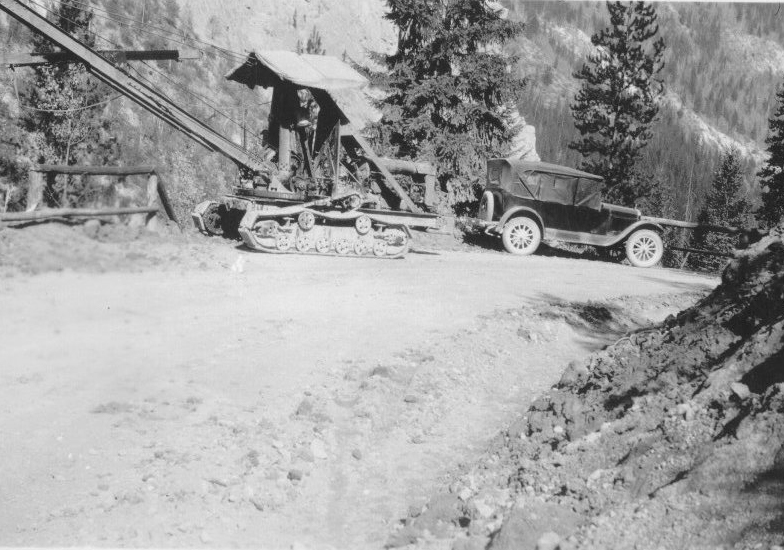Building the Kicking Horse Trail

Building The Kicking Horse Trail
From 2000 Golden Memories
The completion of the Kicking Horse Trail marked the end of one of the greatest engineering feats of all time and opened up a transportation route to the west.
In August 1858, James Hector and his small crew set off, on orders from Her Majesty’s government to find a way to get to the western sea. Hector was assigned to investigate the central regions, following the Bow River and to explore as many passes as possible. After many hardships experienced here Hector made only the barest mention of the Kicking Horse Pass, recommending instead the trail across the Bow River towards the North Saskatchewan River.
Twenty-two years later, the Canadian Pacific Railway made the decision to use the Kicking Horse Pass to bring the railway through the Rocky Mountains to the West Coast.
In 1914, the Calgary-Banff road was opened, allowing people to visit the heart of the Rocky Mountains for the first time. This advance spurred others, and in 1923 the road known as the Banff-Windermere Rd. was finished, allowing traffic to come into the Columbia valley. Once in the valley they could link up with other existing trails and carry on to the West or South from there.
Soon an extension was made on the Calgary-Banff road, making it possible for travelers to visit the Pearl of the Canadian Rockies, Lake Louise. In 1926, the Canadian National Parks branch opened up the section from Lake Louise to Field. This section posted an interesting engineering feat because although the distance from Lake Louise to Field was only 16 miles, there is an altitude drop of 1500 feet. This was accomplished with no grade greater than 8%.
The last section of the trail to be finished was from Field to Golden along the Kicking Horse River. Considered to be very thrilling, the road offered no alternatives for the builders involved. They had to use bridges to cross the valley back and forth, getting the best possible footing for roads that seemed almost impossible. Besides all the obvious problems the builders had to take care not to roll rocks onto the rail line below.
600,000 lineal feet of lumber for cribbing had to be brought in to build the road up. The lumber had to be lowered 1200 feet down the side of the gorge, in places, with drums and cables.
Despite the fact that the last 15 miles of the trail, the part through the Canyon, took three years to build, in some of the most hazardous terrain ever encountered, no serious accident ever took place.
Do must be given to the engineers and road builders who first had to pick the route from a dozen possible, keeping in mind the best grades and the best views, with the least expense, and who then had to see the work through to completion, often against impossible odds.
With the completion of the last section of the Kicking Horse Trail from Field to Golden, many sites that had not been available to the public before, now were easily accessible.
The 38 miles from Field to Golden offered sight seekers many exciting new adventures. Starting from field which was mile 0, the first stop of interest was at mile 3, the Natural Bridge a natural outcropping of rock that the river passes under. The second was Emerald Lake and the Amiskwi River. The route to the historic Howse Pass made its way through the Amiskwi valley.
At miles 7.5 the Ottertail river was crossed and led into the main valley that is the tributary valley of Emerald Creek, Amiskwi and Ottertail from the north and Ottertail from the southeast.
Mile 18, was the turn off point for the travelers to make a side trip to Wapta Falls. Back out to the Kicking Horse Trail and West at the 18.5 was the station of line coil.
The 21-mile post, brought you to the West boundary of Yoho Park. Palliser, a small town of logging fame and a CPR station, marked the beginning of the Kicking Horse gorge as well as the 25-mile post. The 26 mile was the highest elevation on the road, at 600 feet above the valley floor. Many of the automobiles had to turn around here and back up the hill on the other side of the river. Their gas tanks were placed in such a way that gas wasn’t getting to the carburetor, causing the motor to stall. Mile 28 brought you into the once booming mining town of Golden. In anticipation of the increased motor traffic that would be brought to Golden many of the local businesses renovated their places to attract the new tourist dollar.
In 1934, the number of cars that pass through the Yoho Park gate, both east and West, was 5441, carrying 15,816 persons. In the time period covered April 1989 to March 1990 700 thousand cars carrying 1.5 million persons passed through.
For more information on the work that is being done through the Kicking Horse Canyon in 2023-24 follow this link https://www.kickinghorsecanyon.ca/
